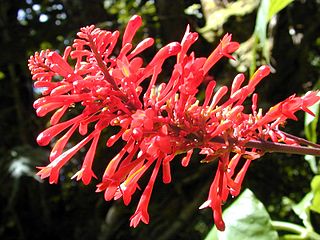
Acanthaceae is a family of dicotyledonous flowering plants containing almost 250 genera and about 2500 species. Most are tropical herbs, shrubs, or twining vines; some are epiphytes. Only a few species are distributed in temperate regions. The four main centres of distribution are Indonesia and Malaysia, Africa, Brazil, and Central America. Representatives of the family can be found in nearly every habitat, including dense or open forests, scrublands, wet fields and valleys, sea coast and marine areas, swamps, and mangrove forests.
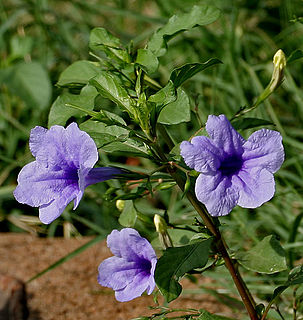
Ruellia is a genus of flowering plants commonly known as ruellias or wild petunias. They are not closely related to petunias (Petunia) although both genera belong to the same euasterid clade. The genus was named in honor of Jean Ruelle, herbalist and physician to Francis I of France and translator of several works of Dioscorides.

The Brandberg is Namibia's highest mountain.
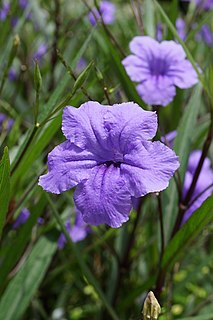
Ruellia simplex, the Mexican petunia, Mexican bluebell or Britton's wild petunia, is a species of flowering plant in the family Acanthaceae. It is a native of Mexico, the Caribbean, and South America. It has become a widespread invasive plant in Florida, where it was likely introduced as an ornamental before 1933.

Ruellia humilis is a species of flowering plant in the family Acanthaceae. It is native to the eastern United States. It is grown as an ornamental plant.
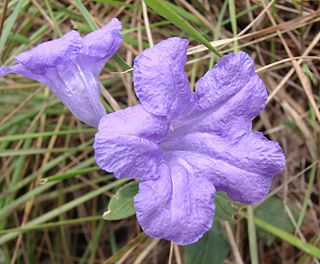
Ruellia geminiflora, known locally as ipecacuanha-da-flor-roxa, is a species native to Argentina; Brazil, typically Caatinga and Cerrado vegetation; Guianas, and Venezuela. The roots of this plant contains possibly toxic substances.
Ruellia hapalotricha is a species native to the Cerrado vegetation of Brazil.

Mackaya neesiana is a plant species in the family Acanthaceae. It has various synonyms including Ruellia neesiana and Asystasiella neesiana. This species is cited in Journals of Travels in Assam, Burma, Bhootan, Afghanistan and The Neighbouring Countries by William Griffith under the synonym Ruellia neesiana.
Acanthopale is a plant genus in the Acanthaceae plant family. The genus name is based on the classic Greek words for thorn ákantha and stake palum. Some species in the genus are cultivated as ornamental plants.
Ruellia dielsii is a species of plant in the family Acanthaceae. It is endemic to Ecuador. Its natural habitat is subtropical or tropical moist montane forests.
Ruellia dioscoridis is a species of plant in the family Acanthaceae. It is endemic to Yemen. Its natural habitats are subtropical or tropical dry shrubland and subtropical or tropical dry lowland grassland.
Ruellia insignis is a species of plant in the family Acanthaceae. It is endemic to Yemen.
Ruellia kuriensis is a species of plant in the family Acanthaceae. It is endemic to Yemen. Its natural habitat is subtropical or tropical dry shrubland.
Ruellia paulayana is a species of plant in the family Acanthaceae. It is endemic to Yemen.

Ruellia caroliniensis, the Carolina wild petunia, is a wild petunia with blue or violet flowers that appear in the spring, summer, and autumn. Its leaves are light green. This species is native to the southeastern United States.

Ruellia tuberosa, also known as minnieroot, fever root, snapdragon root and sheep potato, is a species of flowering plant in the family Acanthaceae. Its native range is in Central America but presently it has become naturalized in many countries of tropical South and Southeast Asia.

Phaulopsis imbricata is a shrub native to South Africa. It is also known as Himalayan ruellia. Leaves are opposite, one larger than the other in each pair, usually asymmetrical at the base. Phaulopsis imbricata is a good fodder, the young leaves are eaten as a vegetable and the plant-ash in oil is rubbed into scarifications on the back for rheumatism in Tanganyika. The flowers have an unpleasant smell. It is filed as near-threatened by the IUCN. It is one of the larval host plants of the butterflies great eggfly, tiny grass blue, brown pansy, soldier pansy and marbled elf.
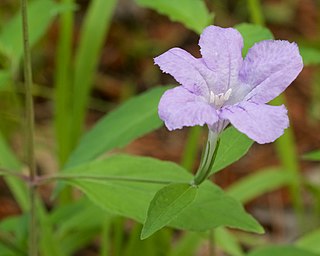
Ruellia pedunculata, the stalked wild petunia, is a wild petunia with blue or violet flowers that appear in the spring. Its leaves are light green. This species is native to the southeastern United States.











